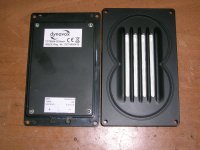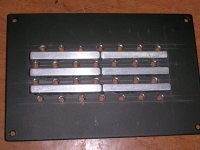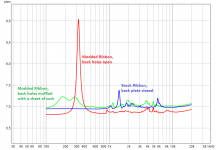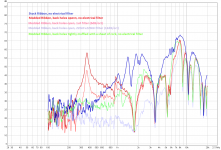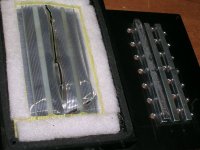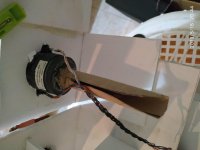I am in the process of designing my first open baffle speaker and didn't like the idea of having two dome tweeters (front and back) or expensive dipole ribbon tweeters.
So I tried some open back paper tweeters/mini full range drivers. Although in some ways they sounded better than my standard dome tweeter they definitively lack sparkle. Even though they measured OK it just sounded dull/muffled.
Although my dome tweeter had more sparkle it sounded constrained.....i mean if you just listened to it with a 6.6uF cap the dome tweeter sounds like a tiny transistor radio. The paper cones sound less whimpy/constrained but as i said no sparkle.
Then I wondered if I could turn my dome tweeter into a dipole so I got out my box cutter and pried of the back of my tweeter. I took out some acoustic foam and was left with a nice round hole. I hooked it up to the amp and was pleasantly surprised. After some listening I decided I didn't really like the sound that came out of the back so I got another idea.
I made a small slotted Karlson pipe and stuck it in the back of the tweeter with some hot glue. This made it sound a lot more balanced. When I A/B test the original and the modified tweeter in small test baffles the sound quality is really day and night. It sounds like a way more expensive tweeter! It has air, detail, realism, depth....
I am a happy camper. I turned my cheap Peerless DX20BF tweeters into something that sounds like it belongs in another league. I acan't wait to to try it with a peerless ring radiator tweeter.....
I don't know if the mod is that easy with other tweeters. But with this Peerless the back comes off in just a few second. Super easy mod and reversible I you don't like the result.
Did I just invent something new or did i reinvent the wheel here? Please let me know the results if you try this modification.
So I tried some open back paper tweeters/mini full range drivers. Although in some ways they sounded better than my standard dome tweeter they definitively lack sparkle. Even though they measured OK it just sounded dull/muffled.
Although my dome tweeter had more sparkle it sounded constrained.....i mean if you just listened to it with a 6.6uF cap the dome tweeter sounds like a tiny transistor radio. The paper cones sound less whimpy/constrained but as i said no sparkle.
Then I wondered if I could turn my dome tweeter into a dipole so I got out my box cutter and pried of the back of my tweeter. I took out some acoustic foam and was left with a nice round hole. I hooked it up to the amp and was pleasantly surprised. After some listening I decided I didn't really like the sound that came out of the back so I got another idea.
I made a small slotted Karlson pipe and stuck it in the back of the tweeter with some hot glue. This made it sound a lot more balanced. When I A/B test the original and the modified tweeter in small test baffles the sound quality is really day and night. It sounds like a way more expensive tweeter! It has air, detail, realism, depth....
I am a happy camper. I turned my cheap Peerless DX20BF tweeters into something that sounds like it belongs in another league. I acan't wait to to try it with a peerless ring radiator tweeter.....
I don't know if the mod is that easy with other tweeters. But with this Peerless the back comes off in just a few second. Super easy mod and reversible I you don't like the result.
Did I just invent something new or did i reinvent the wheel here? Please let me know the results if you try this modification.
Last edited:
When I measure the tweeters the response isn't altered too much. But the harmonic distortion below 4000Hz went up considerably. So I guess this mod rules out using the tweeter in a 2 way design.
How about this one?
I did the same thing with my Accuton BD20 Diamond Tweeter. I know, you modded one of the most expensive tweeters? Idiot!
At high volumes, day and night. There's no going back.
The newer cell drivers don't need this mod, only the older 'plastic backed' ones.
I did the same thing with my Accuton BD20 Diamond Tweeter. I know, you modded one of the most expensive tweeters? Idiot!
At high volumes, day and night. There's no going back.
The newer cell drivers don't need this mod, only the older 'plastic backed' ones.
Hi Erik
The air compliance of the closed back chamber works as an acoustical high pass filter. It doesn't allow the tweeter to produce lower frequencies. At the same time it raises it’s resonance frequency Fr and restricts the amplitude of the impedance peak.
If you open the back chamber, the air loading from the back chamber doesn’t exist anymore. The tweeter produces some lower frequencies and it’s Fr shifts lower with a higher impedance peak. If you run an impedance sweep you will notice all these.
I had done the same by modifying a ribbon tweeter, opening holes at the back plate. You can see the results.
George
PS. During opening and removing the back plate, two neo magnet bars flew off to meet their target, tearing the ribbon. The glue was not as strong as the magnetic pull (see last attachment)
The air compliance of the closed back chamber works as an acoustical high pass filter. It doesn't allow the tweeter to produce lower frequencies. At the same time it raises it’s resonance frequency Fr and restricts the amplitude of the impedance peak.
If you open the back chamber, the air loading from the back chamber doesn’t exist anymore. The tweeter produces some lower frequencies and it’s Fr shifts lower with a higher impedance peak. If you run an impedance sweep you will notice all these.
I had done the same by modifying a ribbon tweeter, opening holes at the back plate. You can see the results.
George
PS. During opening and removing the back plate, two neo magnet bars flew off to meet their target, tearing the ribbon. The glue was not as strong as the magnetic pull (see last attachment)
Attachments
Hi Erik
The air compliance of the closed back chamber works as an acoustical high pass filter. It doesn't allow the tweeter to produce lower frequencies. At the same time it raises it’s resonance frequency Fr and restricts the amplitude of the impedance peak.
If you open the back chamber, the air loading from the back chamber doesn’t exist anymore. The tweeter produces some lower frequencies and it’s Fr shifts lower with a higher impedance peak. If you run an impedance sweep you will notice all these.
I had done the same by modifying a ribbon tweeter, opening holes at the back plate. You can see the results.
George
PS. During opening and removing the back plate, two neo magnet bars flew off to meet their target, tearing the ribbon. The glue was not as strong as the magnetic pull (see last attachment)
I think this mod is great for use as a open baffle super tweeter. I will not cross it below 5000Hz or so. My OB design was supposed to be 3 way but I am tempted to make it a 4 way now with 2x 15" woofers, a 10" bass/mid, 4xTC9FD array and modified tweeter as MMTMM
Member
Joined 2009
Paid Member
My favourite tweeter mod is to push a dent in to it. It doesn't require any special equipment or skills although it's traditionally a modification performed by small children. 😀
The Karlson or K-pipe really helped. I guess it gives the tweeter some kind of loading. It sounds more balanced and controlled. Now I have to experiment with pipe length, slot orientation and maybe even double slots like this
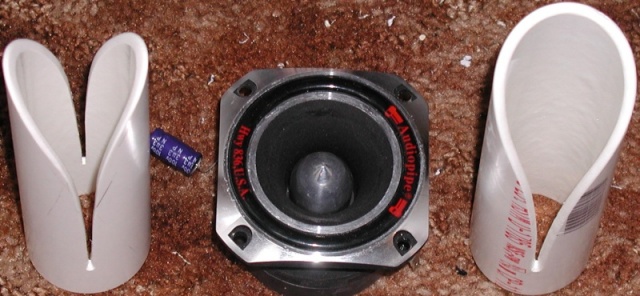

My favourite tweeter mod is to push a dent in to it. It doesn't require any special equipment or skills although it's traditionally a modification performed by small children. 😀
I stumbled upon that mod as well, without the help of child labor....
I just tried that mod on a aludome tweeter, now its sounds twssssiiipppffffssiiiss, not good at all, i want a new driver!
I just tried that mod on a aludome tweeter, now its sounds twssssiiipppffffssiiiss, not good at all, i want a new driver!
I can highly recommend the Peerless DX20BF. The XT25 might be better but this one is cheaper and has the best dispersion I have seen in any tweeter. It doesn't matter where in the room I am I never lose the top octave anywhere. And with my mod it sounds like a 60$ tweeter instead of a 11$ one.
Last edited:
My favourite tweeter mod is to push a dent in to it. It doesn't require any special equipment or skills although it's traditionally a modification performed by small children. 😀
Also works on some fullrange drivers!
Any claims like these without real data (fr measurements on and off axis, distortion, before and after the mod) are misleading...
Any claims like these without real data (fr measurements on and off axis, distortion, before and after the mod) are misleading...
Those are strong words my friend. If we follow that philosophy we will all end up with B&W nautilus speakers.
Here is my scientific method. I was a/b testing the modified and unmodified tweeter when my girlfriend came home. She sat down and after 30 seconds pointed to the unmodified tweeter and said "that one sounds bad". (she couldn't see which one was modded) If she can hear the improvement I can tell you with certainty it is a massive improvement.
So there you have it. I have scientific proof it works!
I heard so many well regarded speakers designed by armies of engineers with millions of dollars of measuring gear and an-echoic chambers that sound sterile, boring and fatiguing.... I just follow my ears and do what sounds best. I do measure once in a while to verify I do not stray too far into the woods but my ears are king.
If you want good easy dipole tweeter, get an B&G planar tweeter and remove the back cup.
Sure, I believe you. But we are talking a price difference of nearly a factor 10. I am talking about a lowly 11$ peerless silk dome here
I get more pleasure from squeezing amazing performance out of budget parts than just buying the best premium parts. I am trying to get the most sound per dollar from cheap and mid price parts like entry level stuff from the likes of Peerless and Dayton and cheap pro woofers...
Hi Erik
The air compliance of the closed back chamber works as an acoustical high pass filter. It doesn't allow the tweeter to produce lower frequencies. At the same time it raises it’s resonance frequency Fr and restricts the amplitude of the impedance peak.
If you open the back chamber, the air loading from the back chamber doesn’t exist anymore. The tweeter produces some lower frequencies and it’s Fr shifts lower with a higher impedance peak. If you run an impedance sweep you will notice all these.
I had done the same by modifying a ribbon tweeter, opening holes at the back plate. You can see the results.
George
PS. During opening and removing the back plate, two neo magnet bars flew off to meet their target, tearing the ribbon. The glue was not as strong as the magnetic pull (see last attachment)
Similar thing happened to me recently when I was opening up a Hygeia RT-62041 planar ribbon! The stock glue let go and two neo bars attached themselves to the front plate ruining the diaphragm. Luckily I have extra diaphragms. Although I won't be going as far as drilling holes, I want to try out a few other things.
- Status
- Not open for further replies.
- Home
- Loudspeakers
- Multi-Way
- Amazing dome tweeter modification. Try it!
